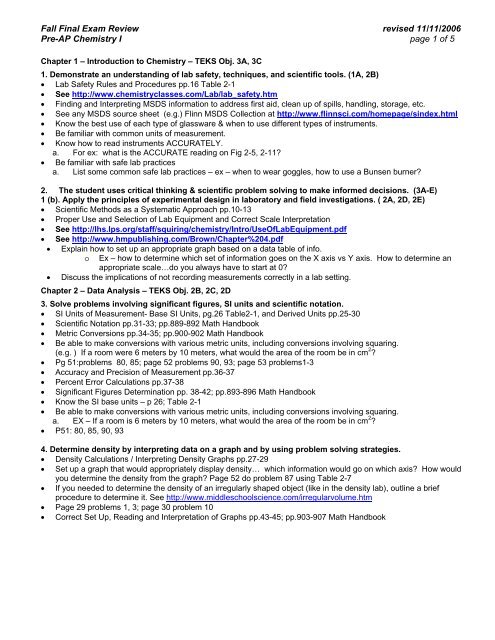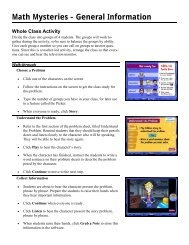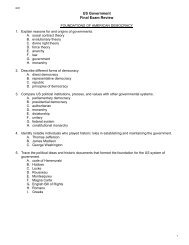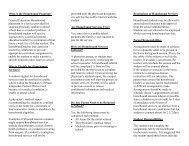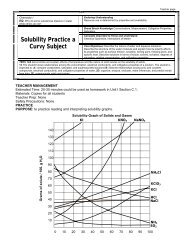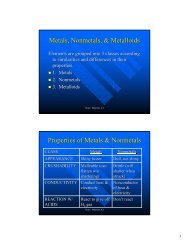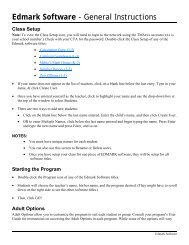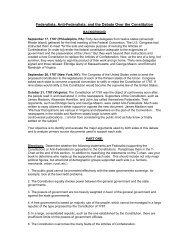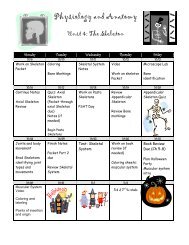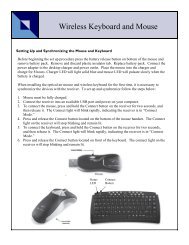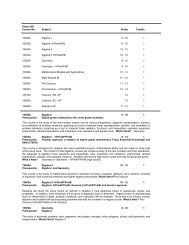Fall Final Exam Review revised 11/11/2006 Pre-AP Chemistry I ...
Fall Final Exam Review revised 11/11/2006 Pre-AP Chemistry I ...
Fall Final Exam Review revised 11/11/2006 Pre-AP Chemistry I ...
You also want an ePaper? Increase the reach of your titles
YUMPU automatically turns print PDFs into web optimized ePapers that Google loves.
<strong>Fall</strong> <strong>Final</strong> <strong>Exam</strong> <strong>Review</strong> <strong>revised</strong> <strong>11</strong>/<strong>11</strong>/<strong>2006</strong><br />
<strong>Pre</strong>-<strong>AP</strong> <strong>Chemistry</strong> I page 1 of 5<br />
Chapter 1 – Introduction to <strong>Chemistry</strong> – TEKS Obj. 3A, 3C<br />
1. Demonstrate an understanding of lab safety, techniques, and scientific tools. (1A, 2B)<br />
• Lab Safety Rules and Procedures pp.16 Table 2-1<br />
• See http://www.chemistryclasses.com/Lab/lab_safety.htm<br />
• Finding and Interpreting MSDS information to address first aid, clean up of spills, handling, storage, etc.<br />
• See any MSDS source sheet (e.g.) Flinn MSDS Collection at http://www.flinnsci.com/homepage/sindex.html<br />
• Know the best use of each type of glassware & when to use different types of instruments.<br />
• Be familiar with common units of measurement.<br />
• Know how to read instruments ACCURATELY.<br />
a. For ex: what is the ACCURATE reading on Fig 2-5, 2-<strong>11</strong>?<br />
• Be familiar with safe lab practices<br />
a. List some common safe lab practices – ex – when to wear goggles, how to use a Bunsen burner?<br />
2. The student uses critical thinking & scientific problem solving to make informed decisions. (3A-E)<br />
1 (b). Apply the principles of experimental design in laboratory and field investigations. ( 2A, 2D, 2E)<br />
• Scientific Methods as a Systematic Approach pp.10-13<br />
• Proper Use and Selection of Lab Equipment and Correct Scale Interpretation<br />
• See http://lhs.lps.org/staff/squiring/chemistry/Intro/UseOfLabEquipment.pdf<br />
• See http://www.hmpublishing.com/Brown/Chapter%204.pdf<br />
• Explain how to set up an appropriate graph based on a data table of info.<br />
o Ex – how to determine which set of information goes on the X axis vs Y axis. How to determine an<br />
appropriate scale…do you always have to start at 0?<br />
• Discuss the implications of not recording measurements correctly in a lab setting.<br />
Chapter 2 – Data Analysis – TEKS Obj. 2B, 2C, 2D<br />
3. Solve problems involving significant figures, SI units and scientific notation.<br />
• SI Units of Measurement- Base SI Units, pg.26 Table2-1, and Derived Units pp.25-30<br />
• Scientific Notation pp.31-33; pp.889-892 Math Handbook<br />
• Metric Conversions pp.34-35; pp.900-902 Math Handbook<br />
• Be able to make conversions with various metric units, including conversions involving squaring.<br />
(e.g. ) If a room were 6 meters by 10 meters, what would the area of the room be in cm 2 ?<br />
• Pg 51:problems 80, 85; page 52 problems 90, 93; page 53 problems1-3<br />
• Accuracy and <strong>Pre</strong>cision of Measurement pp.36-37<br />
• Percent Error Calculations pp.37-38<br />
• Significant Figures Determination pp. 38-42; pp.893-896 Math Handbook<br />
• Know the SI base units – p 26; Table 2-1<br />
• Be able to make conversions with various metric units, including conversions involving squaring.<br />
a. EX – If a room is 6 meters by 10 meters, what would the area of the room be in cm 2 ?<br />
• P51: 80, 85, 90, 93<br />
4. Determine density by interpreting data on a graph and by using problem solving strategies.<br />
• Density Calculations / Interpreting Density Graphs pp.27-29<br />
• Set up a graph that would appropriately display density… which information would go on which axis? How would<br />
you determine the density from the graph? Page 52 do problem 87 using Table 2-7<br />
• If you needed to determine the density of an irregularly shaped object (like in the density lab), outline a brief<br />
procedure to determine it. See http://www.middleschoolscience.com/irregularvolume.htm<br />
• Page 29 problems 1, 3; page 30 problem 10<br />
• Correct Set Up, Reading and Interpretation of Graphs pp.43-45; pp.903-907 Math Handbook
<strong>Fall</strong> <strong>Final</strong> <strong>Exam</strong> <strong>Review</strong> <strong>revised</strong> <strong>11</strong>/<strong>11</strong>/<strong>2006</strong><br />
<strong>Pre</strong>-<strong>AP</strong> <strong>Chemistry</strong> I page 2 of 5<br />
Chapter 3 – Matter – Properties and Change – TEKS Obj. 4A, 4B, 4C, 5A<br />
5. Differentiate between physical and chemical properties of matter, as well as physical and chemical changes<br />
in matter. (4A)<br />
• Properties of Matter: Intensive vs. Extensive / Physical vs. Chemical pp.55-59; pp.61-62; pg. 82: 39,41,70;<br />
pg. 85 problems 4,10<br />
• If you have a substance that goes through a type of change that involves a color change, how can you determine if<br />
it was a chemical or physical change?<br />
• Fill in the chart describing the differences between solid, liquid, & gas as they go through phase changes<br />
SOLID LIQUID GAS<br />
Fluidity<br />
Compressibility<br />
Relative speed & movement<br />
of particles<br />
Space between particles<br />
Effects of container on<br />
Volume<br />
• Law of Conservation of Mass pp.63<br />
• Law of Definite and Multiple Proportions pp.75-77<br />
6. Classify and describe matter as it relates to solid, liquid, & gas (4B) & element, compound, and mixture. (4C)<br />
• States of Matter: Comparing Solids, Liquids, and Gases pp.58-60<br />
• Pure Substances, Elements, Mixtures, and Compounds pp.66-71<br />
• Draw how you would represent an element, a compound, and a mixture of all.<br />
• Periodic Table Elements, Element Symbols pp.72-73<br />
• Pg. 82 problems 43, 46, 48, 49<br />
Chapter 4 – Structure of the Atom – TEKS Obj. 3E, 6A, 6B, <strong>11</strong>B<br />
7. Summarize the history of chemistry in terms of significant scientists’ experiments and their development of<br />
the atomic model. (3E, 6A)<br />
• Early Theories ( Democritus, Aristotle, Dalton, Crooke, Thomson, Millikan, Rutherford, Chadwick) pp.87-97<br />
• <strong>Review</strong> yellow boxes on p 88,89<br />
Theorist<br />
Prior<br />
Understanding of<br />
the Atom<br />
Basics of<br />
Experiment<br />
Results of<br />
Experiment<br />
What they got<br />
credit for<br />
finding<br />
New Model of<br />
the Atom<br />
Democritus<br />
Aristotle<br />
John Dalton<br />
William Crooke
<strong>Fall</strong> <strong>Final</strong> <strong>Exam</strong> <strong>Review</strong> <strong>revised</strong> <strong>11</strong>/<strong>11</strong>/<strong>2006</strong><br />
<strong>Pre</strong>-<strong>AP</strong> <strong>Chemistry</strong> I page 3 of 5<br />
J.J.Thomson<br />
Ernest<br />
Rutherford<br />
James Chadwick<br />
8. Distinguish between atoms and their isotopes including:<br />
• Characteristics and Properties of Subatomic Particles —including location, charge and relative mass pp.92-97<br />
• Atomic Number, Atomic Mass, Isotopes, Isotope stability (6A, 6B) pp.98-104; pg. 836 problem 44<br />
• Radioactivity / Types of Radiation pp.105-107; pp.806-809<br />
• Pg <strong>11</strong>2 problem 48, 49, 50; pg. <strong>11</strong>3 problem 72 complete the table<br />
Location Relative Mass Charge Changing the amt makes a(n)<br />
Proton<br />
Neutron<br />
Electron<br />
Chapter 25 – Nuclear <strong>Chemistry</strong> – TEKS Obj. 9A, 9B, 9C, 9D, <strong>11</strong>B<br />
9. Using nuclear reactions be able to calculate half lives ( 9B ), write and balance nuclear equations. ( <strong>11</strong>B,<br />
<strong>11</strong>C), and apply properties of radioactive particles.<br />
• Types of Nuclear Radiation- alpha, beta, gamma, alpha, positron pp.806-809<br />
Composition Charge Penetrating Ability How to write the<br />
symbol<br />
Alpha<br />
Beta<br />
gamma<br />
• Pg. 819 problems 17-19. Be able to interpret ½ life graphs – ex Fig 25-13 pg. 817; Pg. 839 problems 2,3<br />
• Radioactive Decay / Nuclear Stability pp.810-812<br />
• Writing and Balancing Nuclear Equations pp.813-814<br />
• Transmutation and Calculating Radioactive Decay Half-Life Rates pp.815-818
<strong>Fall</strong> <strong>Final</strong> <strong>Exam</strong> <strong>Review</strong> <strong>revised</strong> <strong>11</strong>/<strong>11</strong>/<strong>2006</strong><br />
<strong>Pre</strong>-<strong>AP</strong> <strong>Chemistry</strong> I page 4 of 5<br />
10. Differentiate nuclear fission and nuclear fusion in terms of masses, reactants, products, amount of energy,<br />
and their properties. (9A)<br />
• Fission and Fusion of Atomic Nuclei pp.821-826<br />
FISSON<br />
FUSION<br />
Fuel source<br />
End product<br />
Advantages<br />
Disadvantages<br />
Practical as energy<br />
source?<br />
Basic process<br />
10. a. Evaluate the commercial use of nuclear reactions and the environmental implications. (3C, 9C, 9D)<br />
• Problems Associated with Nuclear Waste Disposal pp.824-826<br />
• Applications and Effects of Nuclear Reactions pp.827-831<br />
• List several ways that radiation can be used in a positive way.<br />
Chapter 5 – Electrons in Atoms (OMIT section 5.1 & section 5.2) NO TEK Obj.<br />
<strong>11</strong>. Using electron configurations, identify atoms and ions.<br />
• Ground state and ion electron configurations pp. 135-140<br />
‣ Aufbau Principle, Pauli Exclusion Principle, Hund’s Rule<br />
‣ orbital diagrams<br />
Chapter 6 – The Periodic Table and Periodic Law – TEKS Obj. 3E, 4D, 6C<br />
12. Trace the development and identify key features of the periodic table. (3E, 6C)<br />
• Historical Development (Newlands, Meyer, Mendeleev, Mosley) pp.151-153<br />
a. Relate the chemical and physical properties of an element to its position in the periodic table and its electron<br />
configuration.<br />
b. Based on location, make inferences about the chemical behavior of an element as it relates to radius,<br />
ionization energy and electronegativity. (4D)<br />
• Be familiar with Fig 5-17 on pg.135 & how to use it, as well as Fig 6-10 on pg.161 (s,p,d,f block elements)<br />
• Pg. 148 problem 93; pg.149 problem 6; pg. 162 problems 9, 10, 12; pg. 175 problems 56, 65, 73<br />
• From an electron configuration perspective, explain how/why ions are formed.<br />
• Classification of Elements pp.154-162<br />
• Periodic Trends pp.163-169<br />
‣ atomic number, nuclear charge, atomic radii, ionic radii, ionization energy, electronegativity<br />
‣ Relate the chemical and physical properties of an element to its position in the periodic table and its electron<br />
configuration.<br />
‣ Based on location, make inferences about the chemical behavior of an element as it relates to radius,<br />
ionization energy and electronegativity. (4D)
<strong>Fall</strong> <strong>Final</strong> <strong>Exam</strong> <strong>Review</strong> <strong>revised</strong> <strong>11</strong>/<strong>11</strong>/<strong>2006</strong><br />
<strong>Pre</strong>-<strong>AP</strong> <strong>Chemistry</strong> I page 5 of 5<br />
Chapter 8 and 9– Ionic Bonding and Covalent Bonding - TEKS Obj. 8A, 8B, 8C, <strong>11</strong>A<br />
13. Compare and contrast ionic and covalent bonds, metallic substances, and polymers.<br />
• Ionic Bond Formation and Ionic Compound Properties pp.2<strong>11</strong>-220<br />
• Metallic Bonds and Properties of Metals pp.228-231<br />
• Covalent Bond Formation, Bond Types, Characteristics pp.241-247; Properties pp.266<br />
• Be familiar with polyatomic ions<br />
• Draw a molecular picture of a compound of salt.<br />
• Draw a molecular picture of a compound of water<br />
IONIC<br />
Types of<br />
Elements<br />
Involved<br />
What<br />
happens to<br />
electrons?<br />
What types<br />
of<br />
compounds<br />
are made?<br />
Which have<br />
higher<br />
melting<br />
points?<br />
From what do<br />
you decide<br />
how to write<br />
the formula?<br />
Given the formula,<br />
what needs to be<br />
added to the elements<br />
to name?<br />
COVALENT<br />
14. Given the formula name, write the chemical formula or given name, write the formula. (<strong>11</strong>A)<br />
• Naming and Writing Polyatomic Ions pp.919 Table C-8<br />
• Naming and Writing Ionic Compound Formula pp.221-227<br />
• Naming Molecules and Writing Molecular Compound Formulas pp.248-251<br />
• P237: 78,88, 100; p273: 96, 97, 105 (ignore hybrid orbitals), <strong>11</strong>5, <strong>11</strong>6<br />
15. Using Lewis structures, be able to determine bond polarity, predict the shapes of molecules, and<br />
determine if a molecule is polar or non-polar.<br />
• Lewis Dot Structures pp.252-258<br />
• Molecular Shapes pp.259-262; Table 9-3 pg. 260<br />
• Polar and Non-polar Molecules pp.265<br />
Chapter 10 - Chemical Reactions – TEKS Obj. 2C, 5A, <strong>11</strong>B, <strong>11</strong>C<br />
16. Write balanced chemical equations and identify endothermic and exothermic reactions.<br />
• Endothermic and Exothermic Energy in Reactions pp.247; pp.500<br />
• Be able to interpret an energy diagram<br />
• Writing and Balancing Chemical Reactions Equations pp.278-283<br />
• Pg. 305 problems 72/76, 73/77<br />
• Types of Chemical Reactions and <strong>Pre</strong>dicting Reaction Products pp.284-291<br />
• Pg. 305 problems 81,82


